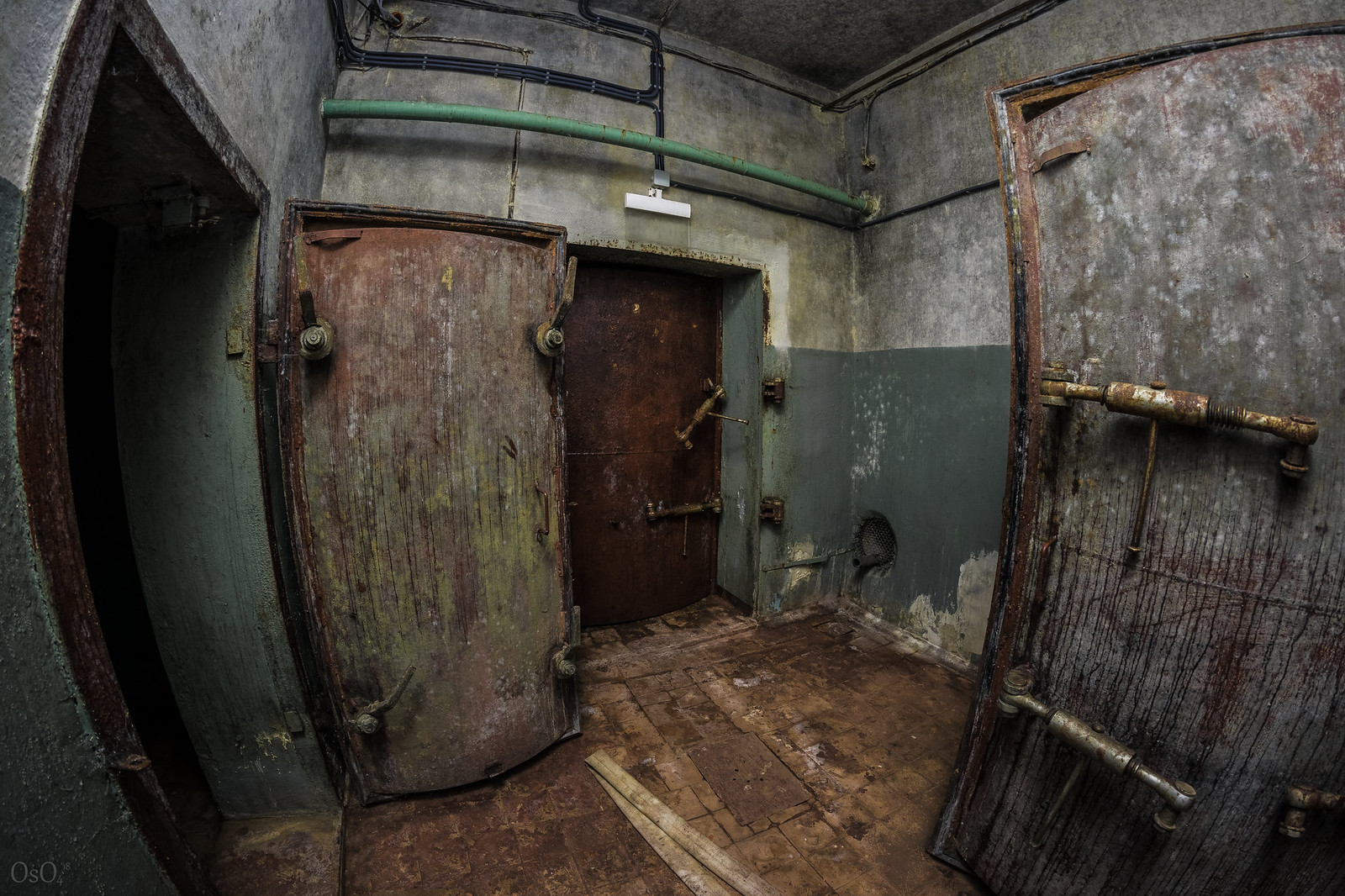In Soviet times, every important government structure had its own special bomb shelter. And the more important was the office, the deeper it was buried. When civilians had to take cover in concrete boxes buried six feet under, the military drilled dozens of meters deep into the ground, and officials of various ministries took shelter in "reserve control points" (RCP).

This shelter was not so lucky. It was re-equipped a few years ago. It was then drowned by and pumped out several times. Hence the fire hoses on the floor.
 The shelter is square-sized with rooms separated by a main corridor running from the main entrance to the emergency entrance, and a second corridor connecting with it. The minister, his council, and his secretary sit in the center. Separately from this square stands the generator room.
Let's start at the main entrance. There are two big hermetic doors and one smaller one leading to the sanitary passageway.
The shelter is square-sized with rooms separated by a main corridor running from the main entrance to the emergency entrance, and a second corridor connecting with it. The minister, his council, and his secretary sit in the center. Separately from this square stands the generator room.
Let's start at the main entrance. There are two big hermetic doors and one smaller one leading to the sanitary passageway. Main corridor.
Main corridor. Shower room, sanitary pass.
Shower room, sanitary pass.


 Next to it is the entrance to one of the ventilation rooms. The main room could not be photographed because it was flooded.
Pre-filters and doors to the air intakes.
Next to it is the entrance to one of the ventilation rooms. The main room could not be photographed because it was flooded.
Pre-filters and doors to the air intakes. Filters.
Filters.

The server room.

 Toilets.
Toilets. Pumping station.
Pumping station.
 Turning right and walking further, you will come to the second exit.
Turning right and walking further, you will come to the second exit.
 Next to the exit is the room of the head of the RCP.
Next to the exit is the room of the head of the RCP. Let's go back and take a look at the offices.
Let's go back and take a look at the offices. The waterproofing is compromised.
The waterproofing is compromised. The lights are not turned on everywhere.
The lights are not turned on everywhere.



 The medical station is very small.
The medical station is very small.

 Somewhere mold has infected everything.
Somewhere mold has infected everything. The office of the deputy minister.
The office of the deputy minister.
 Office of the minister's advisor.
Office of the minister's advisor. Minister's office.
Minister's office.
 Dining room.
Dining room.


 Technical block.
Technical block.
 Battery room and its air exchange system and the rooms next door.
Battery room and its air exchange system and the rooms next door.

 Telephone exchange.
Telephone exchange.

 Teletype.
Teletype. Switchboard.
Switchboard.
 The compressor room and the oxygen tanks rack. On the right, there are stairs to the flooded main ventilation room.
The compressor room and the oxygen tanks rack. On the right, there are stairs to the flooded main ventilation room.
 Pumps.
Pumps. Electrics.
Electrics.

 Stocks of diesel and oil can be found by smell.
Stocks of diesel and oil can be found by smell. The generators are hidden in a separate room behind two doors.
The generators are hidden in a separate room behind two doors. There are two new diesel generators from the UK with a capacity of 200kW each.
There are two new diesel generators from the UK with a capacity of 200kW each. Workbench with tools for their maintenance.
Workbench with tools for their maintenance.
 Fuel tanks and compressed air to start the generator. An assembly box can be seen on the right.
Fuel tanks and compressed air to start the generator. An assembly box can be seen on the right. One of the generators.
One of the generators.

 That's all for now. Time to go outside.
That's all for now. Time to go outside.
 Until we meet again!
Until we meet again!
No comments:
Post a Comment